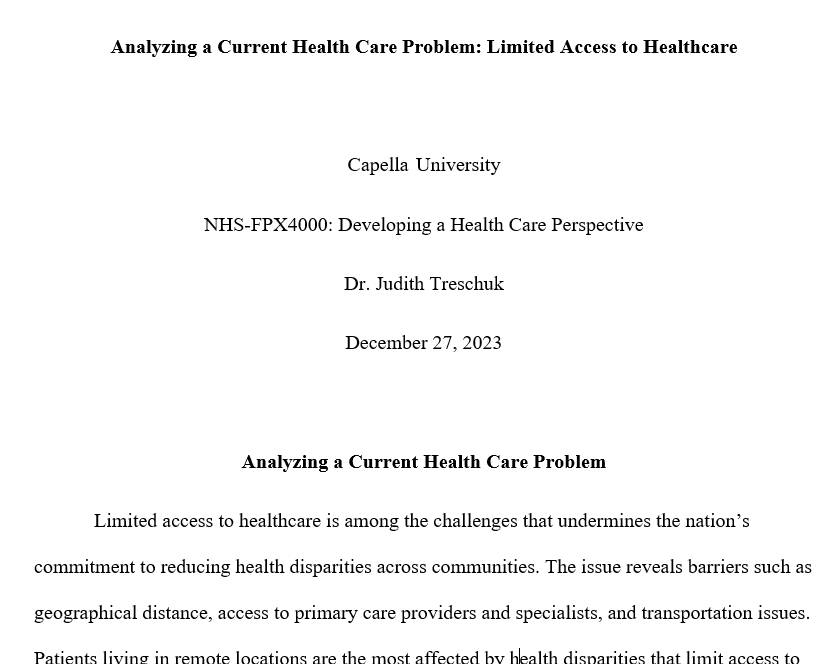Capella University
NHS-FPX4000: Developing a Health Care Perspective
Dr. Judith Treschuk
December 27, 2023
Analyzing a Current Health Care Problem
Limited access to healthcare is among the challenges that undermines the nation’s commitment to reducing health disparities across communities. The issue reveals barriers such as geographical distance, access to primary care providers and specialists, and transportation issues. Patients living in remote locations are the most affected by health disparities that limit access to quality, safe, and cost-effective care. The population experience long waiting times, understaffing, and limited medical supplies that expose them to risks of delayed or postponed care. In the end, the regions experience high morbidity and mortality rates triggered by escalating symptoms. Telehealth is among the options available to reduce health disparities by linking patients to vital health resources such as primary care providers, specialists, and information.
Limited Access to Healthcare
Flexible access to care is a priority for communities seeking to improve quality, safety, and cost of health services. However, limited access to healthcare remains a persistent challenge for populations including those remote and rural areas. The contributors to the issue include poor transportation networks, low education levels, low income, and limited patient monitoring technologies (Bhatt & Bathija, 2018). Poor infrastructure, connectivity, and health promotion and education are other challenges that undermine access to quality care (Dassah et al., 2018). Additional challenges include the lack of insurance coverage, discrimination, and inadequate primary care providers and specialists available to deliver evidence-based and patient-centered care (Bhatt & Bathija, 2018). The disparities reinforce the need for proactive commitment to identifying vulnerable populations and responding using tailored and sustainable solutions. The interventions help reduce morbidity and mortality rates associated with limited access to preventive and treatment measures.
Analysis of Limited Access to Healthcare
Limited access to health care reveals serious gaps in insurance coverage, primary care provider and specialist staffing, racial barriers, and locational challenges. The issue also reveals technological disparities that limit patients, families, and health care professionals from using innovations such as telehealth to overcome challenges in accessing quality, safe, and affordable care. For remote locations, patients may experience limited appointment availability due to inadequate staffing that limit patients from accessing professionals at convenient times. Patients in rural areas struggle accessing clinicians due to geographical disparities. The location barriers expose patients to insufficient access, inappropriate services, and delays that explain the high mortality rates in the regions. Persistent challenges means that vulnerable populations such as children, pregnant women, the elderly, and chronically ill will experience social, economic, and health burden associated with inaccessible care.
Transportation is another concern that keep patients from accessing primary care providers and specialists. Patients may have financial challenges or physical impairment that prevent them from visiting healthcare facilities. Thus, transportation is among the primary social determinants of health (Cyr et al., 2019). The situation reminds stakeholders about the need for solutions such as rideshare companies that help get patients on the road to recovery. Patients may also have limited health literacy that limit them from accessing the right care. The challenge reinforces the need for proactive education to enable patients to access the right type of facility that match their needs (Cyr et al., 2019). High cost of care is also a concern for patients in remote locations. The high out-of-pocket expenses cause patients to skip medical care, follow-ups, and tests. The challenges trigger adverse outcomes such as rising morbidity and mortality threats.
Options for Addressing Limited Access to Healthcare
Sustainable solutions for limited access to care include health information online, telemedicine, and in-home healthcare services. Patients can utilize authoritative websites such as ones sponsored by the Federal government. Patients use computers, tablets, smartphones, and social media to access credible and reliable information on a condition (Naylor et al., 2019). Telemedicine is another evidence-based and patient-centered tool that allows patients to seek health care services without needing to make physical visits (Barbosa et al., 2021). Individuals can access low-acuity services such as chronic care management from their convenient location. Smaller facilities in remote locations can also use telemedicine to coordinate with larger medical centers to handle emergencies. In-home healthcare services are also appropriate for patients affected by health disparities (Dassah et al., 2018). The intervention is ideal for elderly patients who require assistance to manage complex and chronic issues. In-home services are also appropriate to individuals recovering from medical setbacks or have special needs. In this case, nurses, case managers, therapists, and other aids commit to providing care in the home to meet individuals’ needs.
Chosen Solution
Telemedicine is the preferred solution that allows patients to benefit from value and outcome-based care. The technology is a reflection of thoughtful innovations that support timely management of conditions. With significant progress in developing portable such as smartphones and broadband availability in remote locations, telemedicine remains an important consideration for enhancing access to quality, safe, and affordable care (Chu et al., 2021). This way, patients can utilize smartphones, video conferencing, and wireless sensors to receive the desired medical care. For instance, patients with heart failure can utilize telehealth to improve symptoms. The group can utilize telemedicine to access timely medical evaluation and treatment (Gajarawala & Pelkowski, 2021). The goal is to reduce costs associated with readmissions. Patients use messaging and videoconferencing capabilities to enhance compliance and manage complex comorbidities. Implantable hemodynamic sensors are also part of telemedicine that allow patients with heart failure to send and access information about pulmonary arterial pressure. A physician receives alerts about exacerbated symptoms and responds on time to prevent adverse outcomes across the continuum.
Ethical Implications
While telemedicine offers opportunities to improve access to care, ethical barriers undermine its implementation and adoption. Questions emerge about disparities in communication systems, literacy, and access to the technology. Age, socio-economic aspects, and location determine adoption of telemedicine. Inability to access Internet-enabled devices and unreliable connectivity trigger inequalities in using the technology (Barbosa et al., 2021). Privacy and confidentiality issues also emerge due to the risk of compromised data. Guidelines for enhancing privacy and security compliance are necessary to make telehealth reliable in improving access to essential health services (Barbosa et al., 2021). The goal is to eliminate breaches in privacy and data storage associated with online communication. Despite the drawbacks, telemedicine remains a viable and sustainable option for increasing access to care for underserved and under-resourced communities.
Conclusion
Challenges accessing health care expose individuals, families, communities, and the nation to rising health burden. Patients are vulnerable to delayed or postponed care, which worsens their condition and trigger premature deaths. Telemedicine is a viable option for patients to access primary and specialty care using smartphones, tablets, and computers. The technology supports messaging, video conferencing, and remote monitoring features appropriate for facilitating access to evidence-based and patient-centered care.
References
Barbosa, W., Zhou, K., Waddell, E., Myers, T., & Dorsey, R. (2021). Improving access to care: Telemedicine across medical domains. Annual Review of Public Health, 42, 463-481. https://www.annualreviews.org/doi/10.1146/annurev-publhealth-090519-093711
Bhatt, J., & Bathija, P. (2018). Ensuring access to quality health care in vulnerable communities. Academic Medicine, 93(9), 1271-1275. https://www.ncbi.nlm.nih.gov/pmc/articles/PMC6112847/pdf/acm-93-1271.pdf
Cyr, M. E., Etchin, A. G., Guthrie, B. J., & Benneyan, J. C. (2019). Access to specialty
healthcare in urban versus rural US populations: A systematic literature review. BMC
Health Services Research, 19(1). https://doi.org/10.1186/s12913-019-4815-5
Chu, C., Cram, P., Pang, A., Stamenova, V., Tadrous, M., & Bhatia, R. S. (2021). Rural
telemedicine use before and during the COVID-19 pandemic: Repeated cross-sectional
study. Journal of Medical Internet Research, 23(4). https://doi.org/10.2196/26960
Dassah, E., Aldersey, H., McColl, M., & Davison, C. (2018). Factors affecting access to primary health care services for persons with disabilities in rural areas: A “best-fit” framework synthesis. Global Health Research and Policy, 3(36), 1-12. https://ghrp.biomedcentral.com/articles/10.1186/s41256-018-0091-x
Gajarawala, S., & Pelkowski, J. (2021). Telehealth benefits and barriers. The Journal for Nurse Practitioners, 17(2), 218-221. https://www.ncbi.nlm.nih.gov/pmc/articles/PMC7577680/pdf/main.pdf
Naylor, K. B., Tootoo, J., Yakusheva, O., Shipman, S. A., Bynum, J. P., & Davis, M. A. (2019).
Geographic variation in spatial accessibility of U.S. healthcare providers. PLOS ONE,
14(4). https://doi.org/10.1371/journal.pone.0215016



